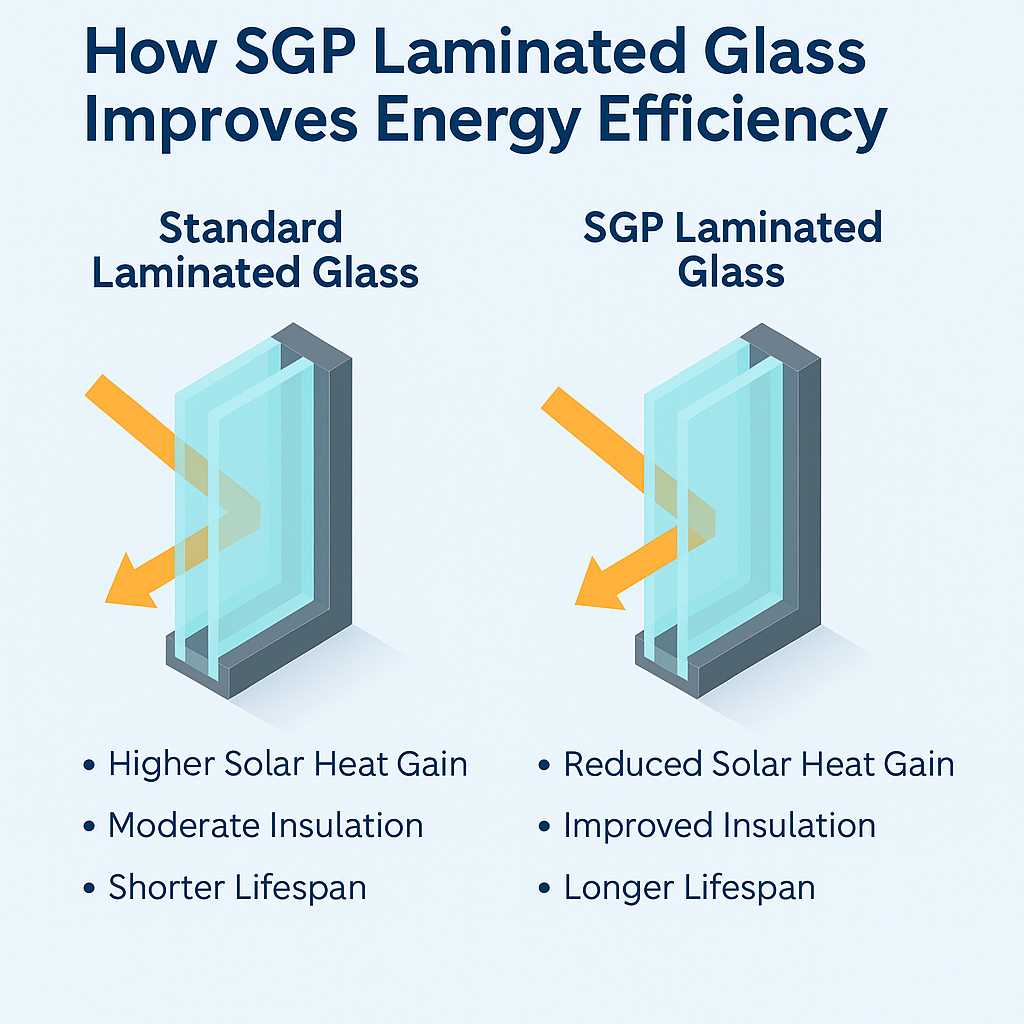In today’s architecture, where sustainability and performance matter more than ever, choosing the right glazing system is essential. SGP (SentryGlas Plus) laminated glass stands out not only for its safety and structural strength but also for its ability to significantly improve energy efficiency in both commercial and residential buildings.
Developed with ionoplast interlayers, SGP laminated glass offers advanced thermal and solar control properties. Its performance exceeds that of standard laminated glass, making it the ideal solution for facades, skylights, and other high-exposure installations where reducing heat gain and energy costs is crucial.
What Is SGP Laminated Glass?
SGP laminated glass is a type of laminated safety glass that uses an ionoplast interlayer instead of the more common PVB (polyvinyl butyral) or EVA (ethylene vinyl acetate). This interlayer is stiffer and stronger, providing better structural integrity, edge stability, and resistance to environmental stress.
Commonly used in:
- High-rise curtain walls
- Overhead glazing
- Balustrades and wind barriers
- Soundproof partitions
Compared to regular laminated glass, SGP laminated glass in architecture offers improved clarity, longer lifespan, and superior performance under harsh weather, UV exposure, and thermal changes.
Learn about general laminated glass features here:
🔗 Laminated Glass
Thermal Performance and Energy Efficiency Benefits
1. Enhanced Solar Heat Control
SGP laminated glass reduces solar heat gain, limiting the amount of infrared energy that enters a building. When combined with low-emissivity (Low-E) coatings or tinted layers, SGP glass can significantly reduce the need for cooling systems during warmer months.
Applications include:
- West- and south-facing windows
- Glass skylights
- Atriums and canopies
By reflecting unwanted heat and controlling glare, SGP laminated glass in design enables the use of large glass panels without sacrificing comfort.
2. Improved U-Value and Insulation
When used in insulated glazing units (IGUs), SGP laminated glass contributes to a lower U-value, which measures how well a window insulates against heat loss. The ionoplast layer provides thermal resistance while maintaining structural support.
Key configurations:
- Double-glazed units with SGP laminated inner or outer panes
- SGP with argon-filled cavities
- Low-E coatings for combined heat retention and reflection
These systems are ideal for buildings seeking LEED certification or improved energy performance ratings.
3. UV Blocking for Interior Protection
SGP interlayers block over 99% of UV rays, preventing damage to flooring, furniture, artwork, and textiles. This benefit is critical in spaces exposed to prolonged sunlight such as:
- Museums and galleries
- Luxury residences
- Retail storefronts
Blocking UV radiation also reduces heat gain, adding to overall energy efficiency and improving air conditioning performance.
4. Better Edge Stability in Hot and Humid Climates
Standard PVB interlayers can absorb moisture, leading to edge bubbling or delamination. SGP laminated glass care is easier in humid or coastal environments because the ionoplast layer resists water intrusion, retaining its seal and clarity.
Benefits in energy efficiency include:
- No need to over-engineer for protection
- Long-term visual clarity for solar management
- Lower replacement and maintenance costs
Installation Best Practices for Energy Efficiency
SGP Laminated Glass Installation Tips
- Ensure fully sealed perimeter glazing
- Use thermally broken aluminum frames or composite frames
- Choose laminated glass with compatible low-E coatings
- Avoid exposing edges to moisture—apply proper sealing
Professional SGP laminated glass installation guarantees optimal performance. Improper handling can reduce its energy-saving potential.
SGP Laminated Glass Maintenance for Performance
Like all glass types, SGP laminated glass maintenance is essential to preserve energy benefits over time:
- Clean regularly with non-abrasive, pH-neutral cleaners
- Inspect seals and edges annually
- Avoid excessive pressure or sharp tools during cleaning
- Ensure drainage systems in skylights or sloped glazing are clear
Proper upkeep protects coatings and interlayers that are critical for insulation and solar control.
Want to preserve clarity while cleaning correctly?
🔗 Laminated Glass Improves Energy Efficiency
Architectural Applications of SGP Laminated Glass
Commercial Buildings
- Glass façades with minimal framing
- Atriums and entrance canopies
- Office partitions with sound and thermal insulation
Residential Projects
- Floor-to-ceiling windows
- Glazed stair railings
- Sunrooms or high-insulation glazed roofs
Public and Cultural Spaces
- Museums, libraries, and government buildings
- Transportation terminals
- Skylights and dome structures
These applications demand high strength, long-term clarity, and consistent energy performance—attributes SGP laminated glass provides reliably.
How Long Does SGP Laminated Glass Last?
Due to its superior edge stability and structural resilience, SGP laminated glass can last 30–50 years in well-installed systems—even in harsh environments. Its resistance to UV, moisture, and thermal cycling ensures it retains energy benefits for decades.
For environment-specific insights, read:
🔗 Laminated Glass Lifespan
SGP Laminated Glass Price Overview
While more expensive than standard laminated glass, SGP glass delivers long-term ROI through:
- Fewer replacements
- Lower energy consumption
- Higher design flexibility
| SGP Laminated Glass Type | Estimated Price per m² |
|---|---|
| Clear SGP Laminated Glass (13.52mm) | $100–$180 |
| Tinted or Low-E SGP Glass | $120–$200+ |
| SGP IGU with argon fill + Low-E | $180–$280+ |
Prices vary based on thickness, coatings, shapes, and manufacturing complexity.
Conclusion
SGP laminated glass is a smart investment for energy-conscious building design. With its superior structural strength, excellent UV filtering, and thermal performance, it helps reduce both operating costs and environmental impact. Whether used in windows, skylights, or architectural facades, it delivers long-term energy savings while enhancing aesthetics and safety.
Learn more about its general benefits:
🔗 Laminated Glass
🔗 Laminated Glass Improves Energy Efficiency
🔗 Laminated Glass Lifespan

